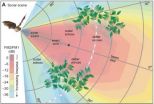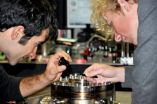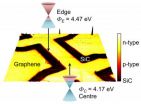(Press-News.org) An international team of scientists has shown that an antibody against the protein EphA3, found in the micro-environment of solid cancers, has anti-tumour effects.
As EphA3 is present in normal organs only during embryonic development but is expressed in blood cancers and in solid tumours, this antibody-based approach may be a suitable candidate treatment for solid tumours.
The researchers from Monash University and Ludwig Cancer Research, in Australia, and KaloBios Pharmaceuticals, in the US, have had their findings published in the journal Cancer Research.
The team, led jointly by the late Professor Martin Lackmann, from the School of Biomedical Sciences at Monash; and Professor Andrew Scott, from Ludwig Cancer Research, has found that even if tumour cells do not have this molecule they can thrive by recruiting and taking advantage of supporting EphA3-containing cells in the tumour micro-environment.
First author, Dr Mary Vail, Monash Department of Biochemistry and Molecular Biology said: "The tumour cells send out signals to the surrounding area and say: 'We need a blood supply and a foundation upon which to spread'."
"We have shown that EphA3 expressing stromal stem cells, which are produced by the bone marrow, form cells that support and create blood vessels in tumours," Dr Vail said.
Professor Andrew Scott's team at Ludwig introduced human prostate cancer cells into a mouse model to mimic disease progression in humans. EphA3 was found in stromal cells and blood vessels surrounding the tumour.
They also observed that treatment with an antibody against EphA3 (chIIIA4) significantly slowed tumour growth. The antibody damaged tumour blood vessels and disrupted the stromal micro-environment, and cancer cells died because their 'life-support' was compromised.
"In addition, we screened various tumours from patient biopsies - sarcomas, melanomas as well as prostate, colon, breast, brain and lung cancers - and confirmed EphA3 expression on stromal cells and newly forming blood vessels," Professor Scott said.
"Our research findings indicate that the tumour micro-environment is important, and monoclonal antibodies against EphA3 are one way to target and kill a variety of solid tumours as well as blood cancers."
Currently, KaloBios Pharmaceuticals is testing the anti-EphA3 antibody KB004 in a multi-centre Phase I/II clinical trial in Melbourne and the US in patients with EphA3 expressing blood malignancies: AML, MDS and myelofibrosis.
Dr Vail, who collaborated with her former mentor on the project for 10 years, said this research represented Martin Lackmann's life work.
"Martin was dedicated to helping people, and believed that KB004 was a promising therapeutic approach. He rightly anticipated that it would be well-tolerated in cancer patients, and through this collaborative project, his pioneering research has progressed to clinical trials and potentially new treatments for cancer patients," Dr Vail said.
INFORMATION:
The research study was funded by ARC, NHMRC and KaloBios Pharmaceuticals.
New ways to treat solid tumors
2014-08-15
ELSE PRESS RELEASES FROM THIS DATE:
Guidelines can predict early menopause in child cancer survivors
2014-08-15
Girls with cancer who are most likely to become infertile after treatment can be identified using guidelines developed almost 20 years ago, new research shows.
The criteria – developed in Edinburgh – will help to select which girls should be offered the opportunity to freeze some tissue from their ovaries for use in the future.
Doctors are optimistic that the frozen tissue could one day help young cancer survivors to have children of their own.
Some cancer treatments can affect female fertility by bringing on early menopause. Freezing samples of ovary tissue before ...
Bats bolster brain hypothesis, maybe technology, too
2014-08-15
PROVIDENCE, R.I. [Brown University] — Amid a neuroscience debate about how people and animals focus on distinct objects within cluttered scenes, some of the newest and best evidence comes from the way bats "see" with their ears, according to a new paper in the Journal of Experimental Biology. In fact, the perception process in question could improve sonar and radar technology.
Bats demonstrate remarkable skill in tracking targets such as bugs through the trees in the dark of night. Brown University neuroscience Professor James Simmons, the review paper's author, has long ...
A study of possible extended symmetries of field theoretic systems
2014-08-15
There has been much recent interest, especially among cosmologists, in theories known as galileons. Galileons are an interesting and novel, though still hypothetical, class of effective scalar fields which are extremely universal and have attracted much recent attention. They arise generically in describing the short distance behavior of the new degrees of freedom introduced during the process of modifying gravity, and in describing the dynamics of extra dimensional brane worlds. Modified gravity and brane worlds are just some of the ideas that have been studied as possible ...
Low vitamin D levels linked to increased risks after noncardiac surgery
2014-08-15
August 15, 2014 – Patients with low blood levels of vitamin D are at increased risk of death and serious complications after noncardiac surgery, suggests a study in Anesthesia & Analgesia.
"Vitamin D concentrations were associated with a composite of in-hospital death, serious infections, and serious cardiovascular events," according to the new research by Dr Alparslan Turan and colleagues of the Cleveland Clinic. They believe their results warrant further study to see if giving vitamin D supplementation before surgery can reduce the risk of these adverse outcomes.
Lower ...
Study: Brain imaging shows brain differences in risk-taking teens
2014-08-15
According to the CDC, unintentional injuries are the leading cause of death for adolescents. Compared to the two leading causes of death for all Americans, heart disease and cancer, a pattern of questionable decision-making in dire situations comes to light in teen mortality. New research from the Center for BrainHealth at The University of Texas at Dallas investigating brain differences associated with risk-taking teens found that connections between certain brain regions are amplified in teens more prone to risk.
"Our brains have an emotional-regulation network that ...
Laser makes microscopes way cooler
2014-08-15
Laser physicists have found a way to make atomic-force microscope probes 20 times more sensitive and capable of detecting forces as small as the weight of an individual virus.
The technique, developed by researchers at The Australian National University (ANU), hinges on using laser beams to cool a nanowire probe to minus 265 degrees Celsius.
"The level of sensitivity achieved after cooling is accurate enough for us to sense the weight of a large virus that is 100 billion times lighter than a mosquito," said Dr Ben Buchler from the ANU Research School of Physics and Engineering.
The ...
Adipose-derived stem cells and nerve regeneration
2014-08-15
Stem cell researchers at the Blond McIndoe Laboratory, University of Manchester, UK, led by Dr Adam Reid, present a review of the current literature on the suitability of adipose-derived stem cells in peripheral nerve repair.
Injuries to peripheral nerves are common and cause life-changing problems for patients alongside high social and health care costs for society. Current clinical treatment relies on sacrificing a nerve from elsewhere in the body to provide a nerve graft at the injury site, but much work has been done to develop a bioengineered nerve graft that would ...
Politicians need to address transport taboos, not just new technology, to meet carbon targets
2014-08-15
Transport accounts for 30% of CO2 emissions in the EU, with emissions rising 36% between 1990 and 2007. The research, carried out by Lund University and the University of Surrey a found a need to dissect the widely-held view that new technologies, such as biofuel and improved aircraft design, will result in carbon reduction targets being met.
In the paper, researchers highlight the fact that policy makers are turning to the perceived benefits of such technologies to drive decarbonisation policy, despite contrary evidence. They argue that in order to cut damaging carbon ...
On the edge of graphene
2014-08-15
Researchers at the National Physical Laboratory (NPL) have discovered that the conductivity at the edges of graphene devices is different to that of the central material.
Local scanning electrical techniques were used to examine the local nanoscale electronic properties of epitaxial graphene, in particular the differences between the edges and central parts of graphene Hall bar devices. The research was published in Scientific Reports, an open access publication from Nature Publishing Group.
The researchers found that the central part of the graphene channel demonstrated ...
TUM researchers develop defense against cyberattacks
2014-08-15
Port scanners are programs that search the Internet for systems that exhibit potential vulnerabilities. According to the report published today by journalists at Heise Online, Hacienda is one such port scanning program. The report says that this program is being put into service by the "Five Eyes," a federation of the secret services of the USA, Canada, the UK, Australia and New Zealand. "The goal is to identify as many servers as possible in other countries that can be remotely controlled," explains Dr. Christian Grothoff, Emmy Noether research group leader at the TUM ...


